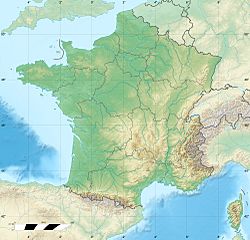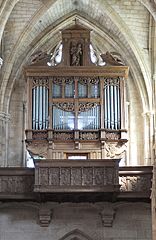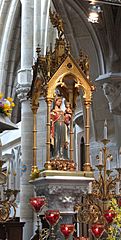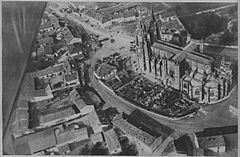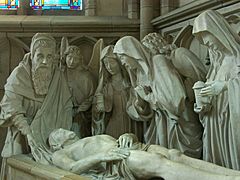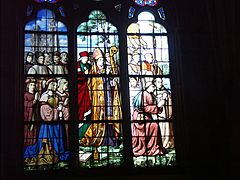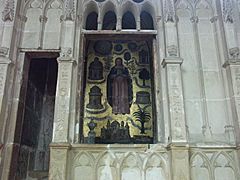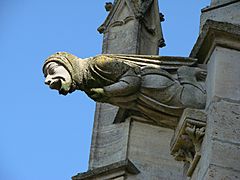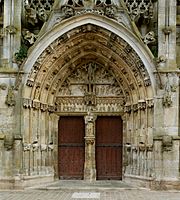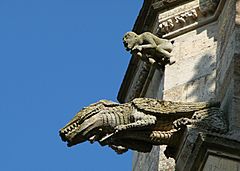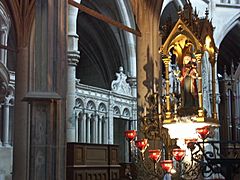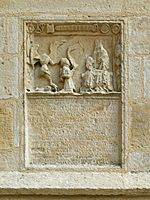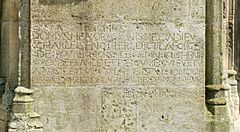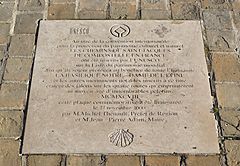Notre-Dame de l'Épine facts for kids
Quick facts for kids Basilique Notre-Dame de l'Épine |
|
|---|---|
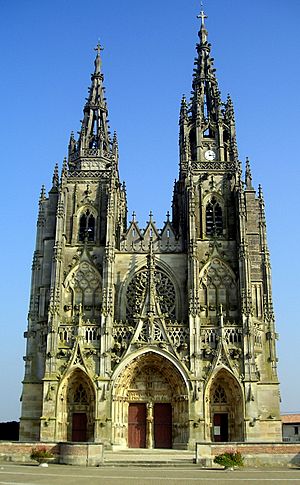
Façade of the Basilica
|
|
| 48°58′38″N 4°28′13″E / 48.97709°N 4.470408°E | |
| Location | L'Épine |
| Country | France |
| Denomination | Roman Catholic |
| History | |
| Founded | 1405 |
| Architecture | |
| Heritage designation | Part of the Routes of Santiago de Compostela in France UNESCO WHS |
| Architectural type | church |
| Style | Gothic Flamboyant |
| Administration | |
| Diocese | Châlons |
The Basilica of Our Lady of l'Épine (which means "Our Lady of the Thorn" in French) is a beautiful Roman Catholic church. It's located in a small village called L'Épine, Marne in France. This amazing building is a great example of the Flamboyant Gothic style, which is a fancy and detailed way of building.
Contents
History of the Basilica
Building a Masterpiece
Construction of the basilica began around 1405 or 1406. It took a very long time to build, finally finishing in 1527. In 1914, this church was given the special title of "basilica."
The Legend of the Thorn Bush
The name "Notre-Dame de l'Épine" comes from a special statue of the Virgin Mary holding baby Jesus. A legend from the 1600s says that shepherds found this statue in the Middle Ages. They discovered it in a thorn bush that seemed to be on fire, but wasn't burning up!
Size and Design
The Basilica of Our Lady of l'Épine is as big as a cathedral. It was built in the traditional Gothic style. The front of the church has three main doorways. It also has two tall, pointed towers called spires.
The Spires' Story
The spire on the right side is about 55 meters (180 feet) tall. The spire on the left side was actually taken down in 1798. This was done to make way for a special telegraph system invented by Claude Chappe. Luckily, the left spire was rebuilt in 1868, so now both spires stand tall again.
Important Recognition
In 1840, the basilica was officially recognized as a historic monument. Later, in 1998, UNESCO added it to the World Heritage List. It's part of the "Roads to St. Jacques de Compostela in France," which are old pilgrimage routes. Many famous writers, like Victor Hugo and Alexandre Dumas, have been inspired by this beautiful basilica.
Inside the Basilica
Amazing Decorations
The basilica has some really cool and unique stone carvings called gargoyles. Inside, you'll find a special screen from the late 1400s called a rood screen. The famous statue of the Virgin Mary, which the basilica is named after, is located in one of its arches.
Statues and Altars
You can see several old statues inside. These include the Venerated Virgin (from around 1300), a seated Virgin (from the 1400s), and a wooden statue of St. Jacques (from the 1600s). The main altars in the church date back to 1542. There's also a large crucifix from the 1500s.
Organs and Stained Glass
The church has a special platform called a tribune and an organ case, both from the 1500s. The tribune is decorated with statues of eight apostles and seven ancient gods. The choir organ was made by Merklin. The beautiful stained glass windows, which let colorful light into the church, were mostly made in the 1800s and 1900s by the Champigneulle company.
Gallery
See also
 In Spanish: Basílica de Nuestra Señora (L'Épine) para niños
In Spanish: Basílica de Nuestra Señora (L'Épine) para niños


